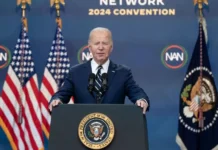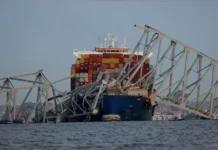Hundreds of cars were left stranded on Interstate 5 headed north from California into Oregon Wednesday following a major storm that dumped snow and created white-out conditions on both sides of the state borders.
Drivers reported being stuck for 17 or more hours in blizzard conditions and some spent the night in their vehicles as large swathes of the country were paralyzed by a ‘bomb cyclone’ and up to 30 inches of snow.
Stranded cars made it difficult for plows to clear the freeway and it was unclear when the northbound lanes would reopen. I-5 was closed in both directions late Tuesday because of the storm. The southbound lanes are said to have reopened at Ashland, Oregon early Wednesday.
Two major winter storms are disrupting the travel plans of millions of Americans headed to Thanksgiving Day destinations on jam-packed highways and airplanes Wednesday.
Those living in the western two-thirds of the country have been badly hit with deteriorating conditions, forcing the closure of interstates and resulting in canceled flights – just as 55 million set off for the holidays.
Travel was particularly perilous over the Siskiyou Summit, one of the more treacherous mountain passes, and just south of the Oregon-California state line.
‘There is a large number of spun out vehicles, large trucks and smaller cars, along the road that didn’t put chains in their tires as required,’ Denise Yergenson, a Caltrans spokeswoman said. ‘That blocked the road and it’s hampering our ability to plow.’
Scroll down for video


Hundreds of cars remained stranded, pictured, on Wednesday on Interstate 5 headed north from California into Oregon in the aftermath of a major storm that dumped snow and created white-out conditions on both sides of the state border


A 100 mile stretch of Interstate 5 in northern California was closed in both directions Wednesday, pictured. Snowfall forced the closure between Yreka and Redding after vehicles spun out along the road


The map above shows the forecast nationwide from Wednesday morning 7am EST through Thursday morning 7am EST


A storm bringing rain is expected to batter most of the East, the Great Lakes will be windy and gusty, the Upper Midwest will be snowy, and precipitation is expected in the West and Southwest on Wednesday


AAA predicted that the number of travelers over a five-day stretch starting Wednesday will be the second-highest, behind only 2005. The forecast for Wednesday evening shows widespread snow and rain is expected across the US


By Thursday morning large swathes of the country will be hit by more snow, rain and icy conditions
Portland, Oregon resident Christina Williams and her 13-year-old son were some of the lucky ones who made it through the storm, but not without plenty of scary moments. They were driving from Oregon to the San Francisco area for Thanksgiving when they first hit snow around Roseburg, Oregon.
Williams said it took them more than 17 hours to reach Redding, California, where they got a hotel room. Conditions were so treacherous, she said, that she was afraid to try to exit the freeway because it was so slippery.
Cars all around them were getting stranded and ice formed on her windshield even while the car was on.
‘There were spin-outs everywhere, there were trucks that were abandoned and every time we stopped and started moving again, there were people who couldn’t start moving again,’ Williams said. ‘Every time we stopped I was like, is this it? Are we going to be here overnight?’
Filmmaker Josh Cantu told ABC 7 he saw cars out of gas and passengers ill equipped for the treacherous weather with little or no snow gear.
At the peak of the storm, Pacific Power said 15,000 customers were without power. That number had dropped to several thousand, mostly in northern California, by Wednesday.
The storm — called a ‘bomb cyclone’ — came ashore near Brookings, Oregon late Tuesday afternoon packing heavy snow and winds gusting up to 106 mph in some coastal areas.
A bomb cyclone forms when air pressure drops 24 millibars or more in a 24-hour period. They are rare in the U.S. West and this storm’s pressure dropped even more precipitously than expected, leading forecasters to say it was one of the worst such storms in the past 15 to 20 years.
Central Oregon also got hit with snow and Oregon State University closed its Bend campus due to weather conditions.
The first storm front was moving across the upper Midwest Wednesday, where it was forecast to clobber parts of Iowa, Wisconsin and Minnesota with almost a foot of snow and wind gusts of up to 50 mph, making travel difficult if not impossible, the National Weather Service (NWS) said.
It also warned of possible winds of up to 60 mph and rainstorms across a wide swath of the central US from western Texas up through Missouri and into Ohio on Wednesday, as millions hit the roads and board airplanes for the holiday.
More than a foot of snow is forecast in parts of Wisconsin Wednesday. A number of schools have already canceled classes in the state as heavy snow and high winds caused worsening travel conditions.
The NWS called the weather set to batter the Northwest through Wednesday a ‘historic, unprecedented’ storm, with hurricane-force winds.


The stranded cars in the I-5 made it difficult for plows to clear the freeway and it was unclear when the northbound lanes would reopen. I-5 was closed in both directions late Tuesday because of the storm, but the southbound lanes reopened at Ashland, Oregon early Wednesday


Motorists navigate an ice and snow-covered road on Wednesday in Mason City, Iowa. A storm pushing across the upper Midwest has been hampering holiday travel on one of the busiest travel days of the year


A pedestrian walks along Portland Avenue near downtown Minneapolis, Wednesday. Blinding snow is falling fast there


A sidewalk cleaner brushes snow off the sidewalk on Superior Street in Duluth, Minnesota. Cold, blustery and snowy weather produced difficult travel conditions across the United States on Wednesday
A winter storm warning from just north of La Crosse to northeast Wisconsin was also in place. In far northern areas of the state, including Bayfield, Ashland and Iron counties, snowfall totals could reach as high as 20 inches. Elsewhere, six inches to 10 inches of snow was expected in northwestern Wisconsin.
Snow is also falling fast in southern Minnesota, where 12 inches or more is expected during the busy travel period. A total of 35 flights had been canceled at Minneapolis-St. Paul International Airport as of Wednesday morning with another 60 delayed.
One of the hardest-hit areas on the day before Thanksgiving Day was Minnesota’s Twin Cities region.
And in Kansas roads are partially or completely snow covered after a storm dumped more than five inches.
Thousands are also without power in Missouri as high winds whip across the state. Ameren reported that 17,871 customers were without service Wednesday morning, mostly in the St. Louis area.
Blowing snow is making travel difficult in southern South Dakota where about two dozen school districts have canceled classes.
And in Utah, a state trooper was forced to dive over a barrier to avoid a car after it lost control in icy conditions and slammed into center median. The incredible moment was captured on dashcam just as Trooper Riley Rugg jumped out of the way on Monday.
Strong winds are also whipping up snow and hampering travelers in Nebraska and Iowa. Gusts could approach 60 mph as the storm heads northeast. A gust of 53 mph was reported Wednesday morning in Davenport.
Far western Nebraska is shoveling out nearly a foot of snow, with drifts up to 16 inches deep.


Travelers queue during the Thanksgiving holiday travel rush at O’Hare Airport in Chicago, Illinois on Wednesday


A man plows snow after a blizzard struck overnight on Tuesday in Minneapolis, Minnesota. Two major winter storms thrashing the western two-thirds of the United States on Wednesday appear set to disrupt the travel plans of millions of Americans headed to Thanksgiving Day destinations on jam-packed highways and airplanes


Heavy traffic moves slowly on I-495 (Capital Beltway) in Bethesda, Maryland on Wednesday. Both the American West and Midwest are facing significant weather events that could impact holiday travelers.


A satellite view of the storms battering the east coast of the US on Wednesday morning as bad weather causes travel chaos
Thousands of passengers were stranded at the Denver International Airport overnight as power outages on the West Coast, widespread road closures and huge pileups on icy roads, add to the mix of travel chaos for millions ahead of the Thanksgiving holiday.
About 10 inches of snow mixed with winds that limited visibility prompted the cancellation of about 30 per cent of the airport´s average daily 1,600 flights.
A total of 491 flights in and out of the Denver airport were canceled as more than 700 flights were delayed on Tuesday.
Southwest Airlines also canceled about 200 flights. Spokesman Brad Hawkins said it would take ‘a couple of days’ to get stranded passengers on other flights because there are few during the pre-Thanksgiving travel crush. That makes it hard for airlines to rebook passengers.
About 1,100 people spent the night at the airport, including many cadets from the Air Force Academy near Colorado Springs who either missed flights or wanted to get to the airport before road conditions deteriorated, airport spokeswoman Alex Renteria said.
By Wednesday morning Denver airport was reporting ‘operations have returned to normal’ but warned it will be a ‘busy day’.
Forecasters said about 21 million people from the West Coast to the Great Lakes are under winter weather advisories and in Southern California and Arizona, another 17 million are under flash-flood watches.
And the treacherous weather jeopardized travel plans for some of the 55 million Americans expected to fly or drive at least 50 miles from their homes for Thursday’s Thanksgiving holiday, according to the American Automobile Association. It caused a more than 60-car pileup along Interstate 90 near Spokane, Washington on Tuesday.
In Fort Collins, Colorado snowboarder Tyler Lugo was filmed being pulled along by a car in the snow on Monday. Lugo said: ‘We just love to ride anything, so when we can’t ride electric longboards, this is the next best thing.’


There are warnings of possible winds of up to 60 mph and rainstorms across a wide swath of the central US from western Texas up through Missouri and into Ohio on Wednesday, as millions will hit the roads and board airplanes for the holiday


There are weather warnings in place with forecasters predicting high winds across Pittsburgh, Chicago and St Louis


The storm dumped a foot of snow in parts of Colorado and buffeted the Denver area with wind gusts of 45 miles per hour. Nearly 500 flights were canceled and more than 350 delayed at Denver International Airport by Tuesday afternoon. Temperatures show Wednesday got off to a chilly start across most of the United States


Kids use umbrellas for protection from the crashing waves as a winter storm arrives in Oceanside, California on Wednesday


Bruce Parker stands amid the crashing waves next to a life guard tower as a winter storm arrives in Oceanside, California
Officials warned residents to stay off the roads until the accompanying high winds die down. By early Wednesday, 8.7 inches of snow was already on the ground in Prior Lake, 7.8 inches at St. Paul and 7.5 inches in Eagan.
Many school districts and universities, including St. Paul Public Schools, the University of Minnesota and University of St. Thomas canceled Wednesday classes as travel conditions deteriorated.
Residents in northeast Louisiana and central Mississippi were cutting up fallen pine trees and assessing damage Wednesday after apparent tornadoes hit the region.
Officials in Mississippi say eight to 10 houses were damaged in Star, a fringe suburb southeast of Jackson. Trees for a time blocked U.S. 49, a major highway.
Damage was also reported from an earlier storm near Baskin, Louisiana, a rural town southeast of Monroe.
No injuries were reported in Mississippi. Initial National Weather Service reports show two people injured when a mobile home flipped in Baskin.


In this still image taken from a Caltrans remote video traffic camera, eastbound Interstate 80 is empty because of closures and restrictions in Soda Springs, California on Wednesday


Travelers arrive at Minneapolis-St. Paul International Airport Wednesday after a blizzard struck overnight. The storm had already closed highways across the region and canceled and delayed hundreds of flights in and out of Denver on Tuesday


Blinding snow is falling fast in Minnesota, pictured Wednesday morning, where 12 inches is expected to accumulate during a busy holiday travel period. Officials warned residents to stay off the roads until the accompanying high winds die down


Snowfalls neared 12 inches in parts of Minnesota on one of the busiest travel days of the year. The first storm front was moving across the upper Midwest, where it was forecast to clobber parts of Iowa, Wisconsin and Minnesota with almost a foot of snow and wind gusts of up to 50 mph, making travel difficult if not impossible, the National Weather Service (NWS) said. A man is pictured pushing a snowblower after a blizzard struck overnight in Minneapolis


A Metro Transit light rail train heads toward downtown as snow continues to fall after a blizzard struck Minneapolis. The treacherous weather jeopardized travel plans for some of the 55 million Americans expected to fly or drive at least 50 miles from their homes for Thursday’s Thanksgiving holiday, according to the American Automobile Association
Oakland International Airport lost power for about 90 minutes Tuesday evening, shutting down its security checks and causing some flight delays and a couple of diversions. Angry passengers shared on social media that the Oakland airport was ‘running on minimal power’.
One user tweeted: ‘Security lines are extended out the door, luggage turnstiles not working. It’s a complete mess.’
It was unclear what caused the outage but it came as thousands of people in Oakland and further south lost power during the storm.
The Federal Aviation Administration (FAA) imposed a ground delay at San Francisco International Airport on Tuesday because of the weather, cutting the number of arrivals in half. The airport reported several hundred delayed flights and about two dozen cancellations.


Ezra Allen sleeps while waiting to board a flight to Tampa Bay at San Francisco International Airport in San Francisco, Tuesday, Northern California and southern Oregon residents are bracing for a ‘bomb cyclone’ that’s expected at one of the busiest travel times of the year. The storm had already closed highways across the region


Oakland International Airport lost power for about 90 minutes Tuesday evening, shutting down its security checks and causing some flight delays and a couple of diversions. Passengers are seen at the airport on Tuesday following the outage


This aerial image shows bumper-to-bumper traffic in Southern California Tuesday night
At least six people were injured after the vehicles crashed down the icy highway Tuesday, according to the Washington Department of Transportation, which subsequently shut down I-90.
Authorities said the six wounded people had non-life threatening injuries and were treated at a local hospital.
According to the NWS branch in Washington state, a fast hitting snow squall snarled traffic in the area, bringing more than half an inch of snowfall within 25 minutes.
One person was killed, and two others were injured in a multi-vehicle crash in Colorado.
Colorado State Patrol Trooper Gary Cutler said a tractor-trailer jackknifed and was hit by two other semi-trucks and a pickup on Interstate 70 near Vail early Tuesday. One of the truck’s fuel tanks burst. A hazardous-materials team was called in to clean up the leaking fuel.
Authorities said roads in the area were warm when the snow started falling, creating icy conditions as the storm strengthened.
According to the Wyoming Department of Transportation, more than 200 miles of Interstate 80 had to be closed due to the heavy snow.
Drivers in Wyoming and Nebraska are dealing with black ice, blowing snow and reduced visibility.
A stretch of Interstate 70 near the state´s western border with Colorado was open again Wednesday after temporarily closing Tuesday at the height of the storm. Kansas Highway Patrol Trooper Tod Hileman urged drivers in a tweet to ‘Stay put,’ adding that it ‘doesn´t look like fun!’ Many travelers took the advice, filling hotels in the area.
The National Weather Service says some of the heaviest accumulations were in Goodland, where 7.5 inches fell, and north of the small village of McDonald, where 9.5 inches was on the ground.


The map above shows the expected snowfall nationwide from Tuesday morning through Thursday evening


A strong storm dropped more than a foot of snow in parts of Colorado and Wyoming and prompted airlines to issue travel alerts Tuesday as the NWS warned of possible blizzards and wintry conditions from Colorado to Michigan


Another major storm is expected to descend on the West Coast over Tuesday and Wednesday, bringing ‘bomb cyclone’ conditions with over two feet of snow to the mountains in the Northwest and possible flash flooding in Southern California
NWS meteorologist Brent Hewett in Chanhassen, Minnesota, said the Minneapolis-St Paul metropolitan area could see its biggest November snowfall in nearly a decade, and travel is northwestern Wisconsin ‘is going to be chaotic’.
In Minneapolis Delta prepared by filling de-icing tanks, calling in extra flight dispatchers and operations employees, and having some of its 20 in-house meteorologists focus on the forecast there.
‘The timing is very helpful,’ said Erik Snell, a Delta senior vice president who oversees operations. ‘It gives the airport time to clear the runways, although we’ll have to watch the residual snowfall in the morning.’
A raw, blustery day is forecast Wednesday, with winds up to 35mph. Forecasters said another storm could arrive this weekend, just as people are returning from Thanksgiving.
‘It’s one of those things, you couldn’t make it up if you tried,’ Hewett said of back-to-back storms falling around the holiday.
Many government offices closed in the Denver area and Cheyenne, Wyoming, along with colleges and schools not already on holiday break.
In Nebraska, several school districts canceled classes Wednesday, and the southwestern city of Sidney had received about eight inches of snow.
Multiple roads were closed in southern Oregon due to downed trees and power lines and blizzard-like driving conditions and others were reduced to a single lane, the Oregon Department of Transportation said.
The ‘bomb cyclone’ could bring waves of up to 35 feet, wind gusts of up to 75mph and heavy snow in the mountains.
Angela Smith said the Oceanfront Lodge, a hotel she manages in Crescent City, in far Northern California, lost power briefly during rain and strong winds. She said the hotel is ready to withstand heavy downpours.
‘It’s blowing pretty good outside but because we’re right on the coast, everything was built to ensure the safety of people,’ Smith said.
Forecasters warned of ‘difficult to impossible travel conditions’ across much of northern Arizona later this week as that storm dumps about two feet of snow.
The approaching storm accelerated the annual winter closure of the highway leading to the North Rim of the Grand Canyon by five days.


The first storm moved into the Plains late Tuesday, bringing high wind and more snow to Minnesota, Wisconsin and upper Michigan. Minneapolis could see more than six inches of snow into Wednesday, along with wind gusts of 35mph


Record-low temperatures are expected in several major cities on Thanksgiving thanks to the first of the two storm systems


The second storm brought snow to the mountains and wind and rain along the coasts of California and Oregon on Tuesday. It’s expected to move inland by the weekend
The leading edge of the first storm system moved into the Mississippi River Valley Tuesday night. It could bring another round of snow to the Upper Midwest from Thursday through Saturday, and a chance of snow this weekend in interior New England, according to NWS meteorologist Alex Lamers.
‘That could be a coast-to-coast storm,’ Lamers said.
It also could mean disappointment for fans of the larger-than-life balloons flown at Macy’s Thanksgiving Day Parade in New York.
Organizers were preparing for the possibility that they’ll have to ground the iconic balloon characters, given 40-50 mph gusts in the forecast.
Rules put in place after several people were injured by a balloon years ago require lower altitudes or full removal if sustained winds exceed 23 mph and gusts exceed 34 mph.
The decision will be made on parade day.
Meteorologists have warned that southern Oregon will likely see one of the coldest Thanksgiving Days on record following weeks of mild fall weather.
Dangerous winds from the gathering storm on Monday flipped a tractor-trailer, downed power lines and temporarily closed a stretch of US Highway 6 south of Yosemite National Park near Bishop, California.
That storm is expected to move inland by Thursday, crossing the US and landing on the East Coast by the end of the weekend.


Weather warnings are in effect across more than half of the country, including major transport hubs such as Los Angeles, Denver, Minneapolis, and Chicago
This month, AAA predicted that the number of travelers over a five-day stretch starting Wednesday will be the second-highest, behind only 2005, despite rising costs for a road trip.
At the start of the week, a gallon of regular cost $2.59, up three cents from a year ago, and rental cars averaged around $75 a day – their highest Thanksgiving price since AAA started keeping track in 1999.
Hotel rooms are a mixed bag, with prices falling from last year at highly rated hotels but rising slightly at mid-range ones.
People might feel they can afford a trip because of low unemployment, rising household net worth, and the stock market´s continuing strength.
For those who are flying, the airlines expect traffic to be up about four per cent from this time last year.


On Wednesday residents are likely to see considerable delays in airports across the country


Thanksgiving Day is usually a light travel day for the airlines, but delays are still expected in the West as well as Texas


Most of the country will be blanketed by either rain or snow on the day after Thanksgiving, though the coastal regions are not forecast to be impacted by the weather


Saturday will also see substantial precipitation in much of the country, according to this graphic


Rain and snow in the Northwest, Midwest, Northeast and the South could stall travel at the end of the holiday weekend
Airlines added about 850 flights and 108,000 seats per day on average to handle the increase over last year´s crowds, according to the trade group Airlines for America.
Airline travel before Thanksgiving tends to be spread out over several days, but most people want to go home on the Sunday or Monday after the holiday.
American Airlines plans to operate 7,046 flights Sunday, just one less than on August 8, its heaviest schedule this year.
In all, 22 of American’s 23 busiest days occurred during the summer vacation season, with this Sunday being the only exception.























